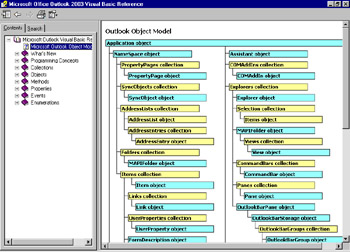Chapter 6: The Outlook Object Model
Overview
Two object libraries are available to you for creating Outlook applications: the Microsoft Forms 2.0 object library and the Microsoft Outlook object library. The Microsoft Forms 2.0 object library contains all the built-in controls for creating Outlook forms (discussed in Chapter 4), including text boxes, list boxes, and multipage controls. It is in the file called Fm20.dll. If you've developed Microsoft Office applications, you'll be familiar with these controls ”they are the same controls you use to create forms in the other Office applications.
The Microsoft Outlook object library is in the file Msoutl.olb. It contains the objects you can use to develop custom Outlook solutions. It is not necessary to have a reference to either of these two libraries in your Outlook forms. Outlook automatically references the libraries so you can start taking advantage of their powerful features.
| |
The documentation provided by Outlook can be very helpful when you create applications. The documentation file is Vbaol11.chm. (For Outlook 2002, the file is called VBAOL10.chm.) These files are normally stored in Program Files\Microsoft Office\ folder hierarchy, and you can also find both of these files on the book's companion Web site. The help file includes information about the Outlook object library and the Forms object library (as shown in Figure 6-1). Note that you must select the option to install VBA help in the custom settings for Office setup to have these files loaded onto your computer.

Figure 6-1: The Outlook Object Model hierarchy from the Outlook help file.
These help files include not only detailed information about the Outlook objects and controls in the libraries but also code samples to help you get started with the objects. This documentation is a great reference tool to use in conjunction with this book: the documentation outlines the objects and their properties, methods , and events, and this book shows you how to implement those objects to create complete solutions.
To access the Outlook object help file in Outlook, open a form in design mode. From the Form menu, choose View Code. From the Help menu, choose Microsoft Outlook Object Library Help.
The Outlook object library contains many objects. Because of the sheer volume and scope of functionality of these objects, I won't cover all of the objects in detail in this chapter. Instead, you should refer to the Outlook help file and MSDN to get the necessary base information about the Outlook objects. We will focus more on how to use the objects.
| |
EAN: 2147483647
Pages: 227